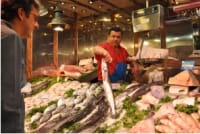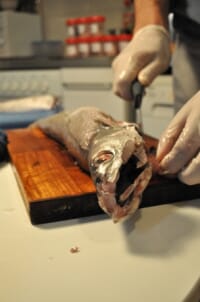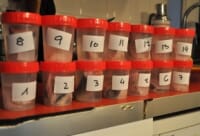
Consumers in Spain trust the mild-flavored white flesh of hake, the most popular fish in a country that eats more seafood than almost any other in Europe. Hake is considered safe for pregnant women, and kids crunch into the cod-like fillets as fishsticks.
“There’s trust because of the cultural bond,” said Cristina San Martín, head of quality and food safety at Fedepesca, a trade group representing Spanish fish retailers. “You see it from the time you’re a kid, and it also has a good price.”
What Spaniards probably don’t know is that the fish they take home for dinner might not be hake at all.
The Spanish public is being cheated by a seemingly pervasive and dangerous form of commercial fraud: Different species — including cheaper fish such as catfish from Viet Nam and grenadier from the Pacific Ocean — are sold as hake in markets across Madrid.
A DNA study commissioned by the ICIJ found in July that nearly one in 10 fish were mislabeled. A study completed last year by the same scientists found mislabeling in nearly 40 per cent of samples.
“Some of the revealed cases are really ‘cheeky’ and shockingly blunt attempts to fool consumers,” said the European Commission’s top fisheries DNA expert Jann Martinsohn, who reviewed ICIJ’s methodology and findings. “And worse, they are not unique.”
Hake is big business in Spain, where sales exceed €1 billion a year. Mislabeling could bump the bottom line of companies that pass off cheap fish as higher-quality fillets, and may even mask illegal fishing, marine biologists and economists say.
The European Union has strict regulations requiring that a paper trail follow fish from ship to shop. But the law doesn’t require that inspectors implement DNA testing to verify accurate labeling.
“The majority [of mislabeling] is commercial fraud,” said Ricardo Pérez, DNA expert and investigator of the Spanish National Research Council. “In recent years there’s been an increase of it, I think because companies know they’re not being watched.”
Mislabeling seafood is a global phenomenon. The environmental group Oceana reported in May that studies in different countries around the world found between 25 to 70 percent of the fish being mislabeled. In the United States, tilapia was sold as red snapper. In South Africa, mackerel was sold as barracuda. In New Zealand, protected hammerhead shark was sold as lemon shark.
Europe’s top department store El Corte Inglés pulled a batch of more than a ton of mislabeled fish from its shelves when told of ICIJ’s findings.
The majority of markets that carried mislabeled fish attributed the problem to human error. And every one of the eight shops where ICIJ found mislabeled samples said it was a one-time occurrence. Authorities in Spain seemed to agree. They said they didn’t think the results of ICIJ’s study were significant enough to show a trend, or present a major threat to the public.
Almost half Spain’s consumers buy their food in or near Madrid. Yet in 2010, regional and city authorities taxed with controlling consumer goods used scientific testing to identify fish species of 59 samples — about a third the number included in the ICIJ study. One thing appears clear: Consumers are largely ignored in the equation.
“What they [authorities] answer, is, ‘will somebody die? No. Well, then it’s only money,’” said Gemma Trigueros, nutritional coordinator at the Spanish Consumers and Users Association (OCU).

What’s on your plate?
Hake is found across the globe — from Argentina and Namibia, to Ireland and New Zealand — and there are at least 12 distinct species of hake in all. Some, like southern African hakes, are cheap. Others, like European hakes, return a higher profit.
Spain imports more than 60 per cent of the hake coming to the EU. So scientists at the University of Oviedo in Spain partnered with a Greek university and last December published findings of a multi-year study.
Their results showed that more than one in three hake products sold in Spain and Greece were not what they appeared. Researchers identified a trend: Cheap species were sold as higher-priced European or American hake, leading scientists to deduce that companies were committing fraud.
Eva García Vázquez, the primary author, did not publish company names in her report and declined to share those with ICIJ, although she said she would have given the information to the government, had officials asked.
So ICIJ undertook a sampling in Madrid to find out if the mislabeling continued and what companies were involved. In June, reporters collected 150 hake samples from major supermarkets, fishmongers and bulk suppliers. ICIJ commissioned the experts at the University of Oviedo to conduct a blind DNA analysis of those products.
DNA testing is better known for its use in forensic analysis, publicised on TV programmes like CSI. Yet the tests are today fairly simple, cheap and quick. And they have a wide range of uses. Thanks to an enzyme-based technique developed in the 1980s, scientists can obtain the DNA sequence from a fish and, by matching it to an online database, identify the species in just one day.
ICIJ’s analysis showed that 8.6 per cent of samples were mislabelled. The researchers concluded that the actual level of mislabeling is likely much higher than what ICIJ’s snapshot study has documented.

“Surely Deliberate”
The most worrisome findings involved entirely different families of fish being sold as hake. Long-bodied Patagonian grenadier from the southern ocean, bulbous-eyed Pacific grenadier found off the coast off of California, and striped catfish pulled from rivers in Viet Nam look nothing alike when they’re swimming. Yet as a frozen fillet, most shoppers just see white fish.
But the fish dealers can tell.
“They don’t even look alike,” said Gonzalo González, a fishmonger whose family has been selling fish since the 1920s and is president of Fedepesca. “Some are whiter than others — like detergent commercials say.”
This helped experts at the University of Oviedo conclude that swapping species was “surely deliberate.”
When alerted to the ICIJ findings, El Corte Inglés, Europe’s largest department store, took immediate action to independently verify the problem. The high-end market said it conducted its own DNA analysis of seven batches of the mislabeled product and found that the samples from one shipment of 1.4 metric tons were also mislabeled.
Further Reading
| - | Go to our previous news item on this story by clicking here. |




